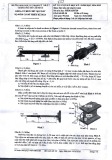
Journal of Science and Transport Technology Vol. 4 No. 3, 1-10
Journal of Science and Transport Technology
Journal homepage: https://jstt.vn/index.php/en
JSTT 2024, 4 (3), 1-10
Published online 04/09/2024
Article info
Type of article:
Original research paper
DOI:
https://doi.org/10.58845/jstt.utt.2
024.en.4.3.1-10
*Corresponding author:
Email address:
doannc@utt.edu.vn
Received: 15/5/2024
Revised: 13/07/2024
Accepted: 18/7/2024
Analysing temperature distributions in
turbine first-stage rotor blades of a helicopter
turboshaft engine
Tien-Duong Le1, Doan Cong Nguyen2,*, Thanh Le Nguyen3
1Le Quy Don Technical University, 236 Hoang Quoc Viet, Hanoi, Vietnam
letienduongdc23@lqdtu.edu.vn
2University of Transport and Technology, 54 Trieu Khuc, Thanh Xuan, Hanoi,
Vietnam, doannc@utt.edu.vn
3Air Force Officer's College, No.03 - Villa Street, Tan Lap Ward, Nha Trang City,
Khanh Hoa, Vietnam; thanhmbdc@gmail.com
Abstract: In helicopter turboshaft engines, turbine blades operate under
extreme conditions. With increasing engine power, the gas temperature
following the combustion chamber can reach approximately 1300 K. The
turbine rotors endure significant centrifugal forces due to their high rotational
speeds. Additionally, they experience thermal and aerodynamic loads from the
flow of combustible gases, which non-uniformly impact the turbine blades at
high temperatures. Furthermore, the mechanical properties of turbine blade
materials are limited and strongly influenced by operating temperatures. This
article presents a numerical investigation focusing on the temperature
distribution of first-stage turbine rotor blades that do not feature internal cooling
channels. The results indicate the regions of peak temperatures and evaluate
rotor blade strength. Comparative analysis between theoretical and numerical
calculations of blade temperature distribution reveals minor disparities:
approximately 30 degrees at the blade shroud, 8 degrees at the mid-span
section, and 15 degrees at the hub. These variations amount to less than 3%
at the shroud, 1% at the mid-span section, and 1.5% at the hub.
Keywords: high-pressure turbine, rotor blade, turboshaft, temperature.
1. Introduction
A helicopter powered by a turboshaft engine
is capable of vertical takeoff and landing, as well as
hovering and flying backwards. Turboshaft engines
have significantly impacted the aviation industry,
providing the necessary power with minimal weight
penalty. Additionally, turboshafts can be scaled to
fit the size of the helicopter, making it the preferred
engine for almost all helicopter models in use today
[1].
The turbine is a crucial component of
turboshaft engines. It can rotate at speeds of up to
20,000 rpm (reaching 19,537 rpm) during takeoff
[2], facing significant centrifugal forces.
Additionally, the turbine is exposed to the extreme
gas temperature after the combustion chamber,
which can reach up to 1300 K [3-7].
Turbine blades frequently experience various
types of damage during engine operation, such as
thermal fatigue resulting in cracking (0), local
overheating, corrosion-erosion damage (0), and
burn-out areas (0).
0 [8] shows a crack on the nozzle blade of a
high-pressure turbine. The crack appears to be

JSTT 2024, 4 (3), 1-10
Le et al
2
concentrated in the blade shroud, an area without
cooling holes. These cracks are due to the
excessive gas temperature impacting the blade,
causing the local high temperature at these points,
ultimately damaging the microstructure of the
material used in the nozzle blade.
Fig 1. Crack regions on the nozzle turbine blade [8]
The combination of temperature, stress and
oxidizing environment leads to diffusion processes
in the surface layers of blades, thereby limiting their
durability [9]. When a fuel-air mixture burns, it
generates a gas flow characterized by high
pressure, temperature and speed. In addition,
turbine blades experience significant stress from
centrifugal and gas-dynamic forces, as well as
exposure to the harsh environment of combustion
products and atmospheric air. Protective properties
may decrease due to erosive wear caused by the
high-temperature gas during operation.
Fig 2. Corrosion-erosion damage on the leading
edge of a high-pressure turbine blade [10]
Visible in 0 [10] is erosion-corrosion damage
of the blade leading edge, resulting from numerous
impacts of solid particles, leading to mechanical
destruction of the coating. the high carbon content
in fuel increases the erosive effect of the gas flow,
accelerating coking on parts and sulfide corrosion,
thereby amplifying the overall destructive impact.
0 [11] shows a photograph of burn-out blades
of a first-stage high-pressure turbine due to
overheating.
Fig 3. Burn-out turbine blades due to overheating
[11]
Unfortunately, our country lacks the
capability to manufacture gas turbine engines or
replacement parts, particularly turbine
components. Consequently, when damage occurs
to turbine blades, the entire turbine components
may be replaced, a process that incurs significant
expenses [2]. Calculating the blade temperature
distribution is the foundation for determining
turbine blade durability and improving the blade
temperature field.
The research conducted by Porreca L. et. al
[12] aimed to enhance the efficiency of designing
gas turbines. Their study focused on developing
advanced calculation methods and tools for

JSTT 2024, 4 (3), 1-10
Le et al
3
determine the temperature distribution of turbine
blades.
Meanwhile, Li Xu et. al [13] addressed the
challenge of designing high-pressure turbine
blades. Their study revealed that existing methods
for calculating external heat transfer conditions
lacked accuracy. As a result, their research aimed
to devise a new, more precise method for
calculating the external heat transfer of gas turbine
blades. Through numerical and theoretical
analysis, the blade temperature distribution was
determined. These results are critical for
understanding the stress distribution and
evaluating the turbine blade durability.
During engine operation, the continuous
combustion generates a high temperature and
pressure flow, directly impacting the turbine blades.
As a result, the blades experience to mechanical
stress due to aerodynamic and centrifugal forces
and undergo abrasion due to chemical corrosion.
In addition, to identify the cause of blade damage,
it is necessary to determine the thermal state,
particularly in cases where the blades lack internal
cooling channels.
Accurately calculating the temperature
distribution is critical for assessing the reduction in
strength of the blade material properties.
2. Numerical models
Various software packages are available for
calculating fluid dynamics and blade temperature
distribution, including Star CCM+, Numeca, Ansys
CFX, and Fluent. However, for this work, the
ANSYS CFX module [14] was chosen due to its
advanced algorithms, which enable reliable, fast,
and accurate solutions [15-19]. This solver is well-
parallelized and offers a wide range of physical
models capable of describing almost all
phenomena related to fluid flow.
In this study, the Ansys CFX (Ansys 2023 R1)
module is used to simulate the fluid dynamics
within the flowpath of the first-stage turbine rotor of
a TV3-117 turboshaft engine. It is important to note
that these rotor blades lack internal cooling
channels, thus the gas temperature will
significantly affect to their working conditions.
Subsequently, the temperature distribution is
calculated and employed as input conditions for
determining the stress field using the Steady-State
Thermal Analysis module. This 1-way Fluid-
Structure Interaction (Fig 4) approach allows for a
comprehensive analysis of the thermal and
mechanical behaviors of turbine blades (Fig 5).
Fig 4. Computational model for calculating the blade temperature distribution
Fig 5. The turbine
rotor blade of the
TV3-117 turboshaft
engine in NX 12
When conducting CFD calculations for the
turbomachinery flowpath, it is advisable to use
hexahedral elements. In this study, the meshing
model was generated by TurboGrid module.
However, to capture detail physical properties
near the boundary layers betwwen the blade and
gas flow, a mesh refinement has been
implemented (Fig 6).

JSTT 2024, 4 (3), 1-10
Le et al
4
Fig 6. Blade cross-sectional mesh generated by TurboGrid module
Fig 7. Boundary conditions at:
1. Inlet; 2. Outlet; 3. Shroud; 4. Hub; 5. Profile; 6,7. Periodic surfaces

JSTT 2024, 4 (3), 1-10
Le et al
5
Fig 8. The total pressure at the outlet depends on the number of grid nodes
Set up the boundary conditions
corresponding to take-off parameters in Fig 7,
which represent the most critical engine operating
mode, based on technical materials [20]. The
following boundary conditions are applied: a total
inlet pressure of 887120 Pa, a total inlet
temperature of 1188 K, a turbine rotation speed of
19537 rpm, and an outlet static pressure of 591413
Pa [2],[6]. The working medium is the ideal gas
under conditions of the energy conservation flow
model (total energy), and the k-ω SST turbulence
model. The convergence condition is set to 1e-4 or
the least mean square RMS of 1%, with a
maximum number of calculation steps set to 500
[9]. To ensure quality calculation results, the
authors conducted research on the grid
dependency of the number of grid nodes on the
calculation results. The results are shown in Fig 8.
Thus, we see that when the number of grid
nodes reaches over 105,000 to nearly 235,000, the
total pressure behind the turbine blade changes
very little. To facilitate calculations, the authors
chose the number of grid nodes for the calculation
to be 174086 nodes and 159720 elements. This
mesh resolution is deemed acceptable and
suitable for subsequent analysis steps.
To analyse the steady-state thermal
conditions and use the results for calculating the
blade temperature distribution in the Steady-State
Thermal Analysis module. This analysis involves
evaluating the thermal equilibrium of a system,
where the temperature remains constant over time.
In other words, it assesses the equilibrium system
state subjected to constant thermal loads and
environmental conditions [14],[20]. In this module,
perform meshing with 149532 nodes and 85081
elements, as shown in 0. From the CFX calculation
results, the "Convection Coefficient" is obtained as
the constraint condition for the Steady-State
Thermal Analysis, depicted in Fig 10.
Fig 9. Meshing model of the turbine rotor blade




















![Bài tập môn Cơ sở thiết kế máy [năm] [mới nhất]](https://cdn.tailieu.vn/images/document/thumbnail/2025/20251008/ltgaming1192005@gmail.com/135x160/26601759980842.jpg)


![Tài liệu huấn luyện An toàn lao động ngành Hàn điện, Hàn hơi [chuẩn nhất]](https://cdn.tailieu.vn/images/document/thumbnail/2025/20250925/kimphuong1001/135x160/93631758785751.jpg)


